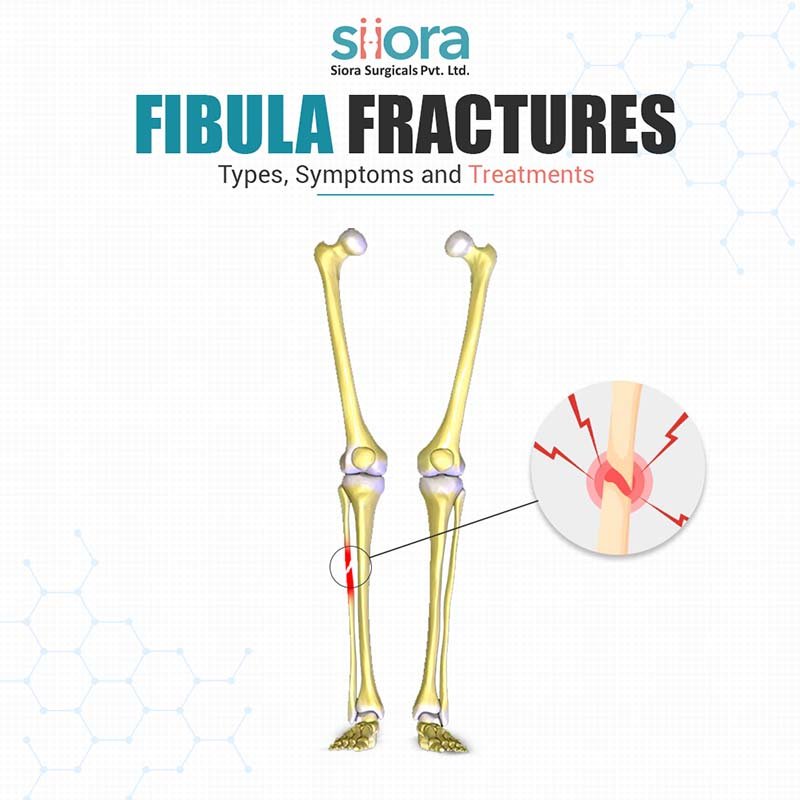A fibula fracture refers to a break in the fibula bone. A forceful impact, such as landing after a high jump or any impact to the outer part of the leg, can cause a fracture. Even spraining or rolling an ankle puts stress on the fibula bone, which can lead to a fracture.
What is a Fibula Fracture?
Fractures in Fibula can happen at any point on the bone and can differ in type and severity. Types of fibula fracture include:
- Lateral malleolus fractures occur when the fibula is fractured at the ankle
- Fibular head fractures occur at the upper end of the fibula at the knee
- Avulsion fractures happen when a small chunk of bone that is attached to a ligament or tendon is pulled away from the main part of the bone
- Stress fractures describe a condition where the fibula is injured as the result of repetitive stress, such as hiking or running
- Fibular shaft fractures occur in the mid-portion of the fibula after an injury such as a direct blow to the area
- A fibula fracture can be because of several tough injuries. It is commonly associated with a rolled ankle but can also be because of a fall, awkward landing, or a direct blow to the outer ankle or lower leg.
Fibula fractures are most common in sports, especially those that involve jumping, running, or quick changes of direction, such as football, basketball, and soccer.
What Are the Types of Fibula Fractures?
Fibula fractures refer to breaks in the fibula, the smaller of the two bones in the lower leg. These fractures can vary in type depending on the location and pattern of the break. The main types include:
- Lateral Malleolus Fracture – This occurs at the lower end of the fibula near the ankle. It is among the commonest type of fibula fracture that occurs because of twisting injuries.
- Fibular Shaft Fracture – Found in the mid-portion of the fibula, this fracture often results from direct trauma or stress-related overuse.
- Proximal Fibula Fracture – Located near the knee, this fracture may occur alongside injuries to the tibia or knee ligaments.
- Stress Fracture – Caused by repetitive stress or overuse, common in athletes and runners.
What Are the Symptoms of Fibula Fractures?
Swelling, pain, and tenderness are some of the most common signs and symptoms of fibula fractures. Other signs and symptoms include:
- Incapability to bear weight on the injured leg
- Bruising or bleeding in the leg
- Visible deformity
- Coldness and numbness in the foot
- Tender to the touch
How to Diagnose Fibula Fractures?
People who have injured their leg and are facing any of the symptoms should consult a doctor for diagnosis. The following steps occur during the process of diagnosis:
- Physical examination: A thorough examination will be conducted, and the doctor will look if there are any deformities
- X-ray: These are used to see the fracture and know if a bone has been displaced
- Magnetic resonance imaging (MRI): This type of test provides a more detailed scan and can generate detailed pictures of the soft tissues and interior bones
Computerized tomography (CT), bone scans, and other tests may be ordered to make a more precise diagnosis and judge the severity of the fibula fracture.
What is the Treatment for Fibula Fractures?
Fibula fracture treatment can differ and depends greatly on how severe the break is. A fracture is classified as closed or open.
Open fracture (compound fracture)
In an open fracture, either a deep wound exposes the bone through the skin or the bone pokes through the skin and can be seen.
An open fracture is mostly the result of a high-energy trauma or direct blow, such as a motor vehicle collision or fall. This kind of fracture can also occur indirectly such as with a high-energy twisting type of injury.
The force needed to cause these types of fractures means that patients will often receive additional injuries. Some injuries could be potentially life-threatening.
According to the American Academy of Orthopedic Surgeons, there is 40% to 70% rate of associated trauma elsewhere within the body.
Doctors will treat open fibula fractures immediately and look for any other injuries. Antibiotics will be administered to avoid infection. A tetanus shot will also be given if it is essential.
The wound will be cleaned thoroughly, examined, stabilized, and then covered so that it can heal properly. An open reduction and internal fixation with bone screws and bone plates may be essential to stabilize the fracture. If the bones are not uniting, a bone graft may be essential to promote healing. Orthopedic implants such as Bone plates and bone screws can be accessible from orthopedic instruments suppliers.
Closed fracture (simple fracture)
In a closed fracture, the bone is broken, but the skin is left intact
The goal of treating closed fractures is to put the bone back in place, control the pain, give the fracture time to heal, prevent complications, and return to the normal function. Treatment begins with the elevation of the leg. Ice is used to relieve the pain and lessen the swelling.
If no surgery is required, crutches are used for mobility and a cast, brace, or walking boot is recommended while healing takes place. Once the area has healed, persons can stretch and strengthen weakened joints with the help of a physical therapist.
There are two main kinds of surgery if a patient requires them:
- Closed reduction involves realigning the bone back to its original position. Here, there is no need to make an incision at the site of fracture
- Open reduction and internal fixation realign the fractured bone to its original position using hardware such as bone screws, orthopedic plates, and rods
The ankle will be placed into a cast or fracture boot until the process of healing is complete.
What Recovery and Rehabilitation is Like After Fibula Fracture Treatment?
The recovery and rehabilitation vary from person to person. However, the standard process after treatment may look like:
Initial Treatment: The fibula is stabilized using a cast, splint, or surgical fixation, depending on the severity of the fracture.
Pain and Swelling Management: Elevation, rest, ice packs, and prescribed medications help reduce pain and inflammation in the early phase.
Immobilization Period: Typically lasts a few weeks, during which weight-bearing is limited or avoided to allow proper bone healing.
Gradual Weight-Bearing: As healing progresses, doctors may allow partial to full weight-bearing using crutches, a walker, or a walking boot.
Physical Therapy: Begins after immobilization and focuses on:
- Regaining joint flexibility and range of motion
- Strengthening muscles around the ankle and lower leg
- Improving balance and coordination
Rehabilitation Duration: Most patients recover in 8 to 12 weeks, but complex cases may take longer.
Activity Modification: High-impact activities are avoided until full healing is confirmed through medical imaging and doctor’s approval.
Follow-Up Care: Regular visits help track healing progress and make necessary adjustments to the recovery plan.
Full Recovery: With consistent care, most individuals regain full function and return to daily activities safely.
What Increases the Risk of a Fibula Fracture?
Here are some of the key factors that increase the likelihood of fibula fractures:
- High-Impact Activities: Sports like football, basketball, and running can stress the fibula, increasing fracture risk.
- Direct Trauma: Falls, car accidents, or hard blows to the leg can cause fractures.
- Osteoporosis: This condition weakens bones, making them more prone to breaks.
- Poor Nutrition: A lack of calcium and vitamin D can reduce bone density and strength.
- Previous Injuries: A history of leg or ankle injuries may weaken the bone over time.
- Improper Footwear: Wearing unsupportive shoes can lead to falls or twisting injuries.
- Weak Muscles: Low muscle strength around the lower leg increases vulnerability.
- Repetitive Stress: Overuse from repeated motions, especially in athletes, can result in stress fractures.
- Poor Lifestyle Habits: Smoking, alcohol abuse, and a sedentary lifestyle negatively affect bone health and healing capacity.
Healthy habits and preventive care are key to reducing fibula fracture risk.
How to Prevent Fibula Fractures?
Preventing fibula fractures involves a mix of good habits, safety measures, and proper body care. Here’s how you can lower your risk:
- Wear Proper Footwear – Use supportive shoes, especially during sports or outdoor activities, to reduce the risk of twisting your ankle.
- Warm Up Before Exercise – Stretch and warm up your muscles to prepare your legs for physical activity.
- Strengthen Leg Muscles – Regularly work on strengthening your calves, ankles, and thighs to support your bones better.
- Improve Balance and Flexibility – Balance exercises can help you stay stable and avoid falls.
- Be Mindful During Sports – Use correct techniques and protective gear when playing sports or hiking.
- Eat Bone-Healthy Foods – A diet rich in calcium and vitamin D keeps your bones strong.
- Listen to Your Body – Don’t ignore pain or fatigue; rest is key to preventing overuse injuries.
Conclusion
In conclusion, fibula fractures, though varying in severity and complexity, require timely diagnosis and appropriate treatment to ensure optimal recovery. Whether resulting from sports injuries, falls, or accidents, understanding the type and extent of the fracture is crucial. Treatment options range from conservative methods like immobilization with casts or braces for stable fractures to surgical interventions involving internal or external fixation for more severe cases. Post-treatment, adherence to rehabilitation protocols, including physical therapy, plays a vital role in restoring strength and mobility. It’s essential to follow medical advice diligently to prevent complications and promote efficient healing. With proper care and patience, most individuals can expect a return to their regular activities, underscoring the importance of comprehensive management in fibula fracture cases.







